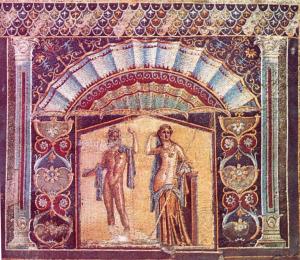
Dyonisus of Halicarnassus attributed the foundation of Herculaneum to Heracles (Hercules) whilst he was coming back from Iberia (Spain), and Strabo reports that the town first belonged to the Oscans (VII century b.C.), then to the Etruscans and finally to the Samnites. Like Pompeii and Stabiae, Herculaneum was also forced to enter the orbit of the Nocera confederation. When it rebelled against Rome during the Social War, it was attacked and conquered in 89 b.C. by the envoy of Silla, Titus Didius, and was thereafter involved in the municipalization process that affected all central-Southern Italy.
The disastrous earthquake in 62 a.D. made many buildings hazardous, and the empereur Vespasian financed the restoration of a big part of the town. But in 79 a.D. the terrible eruption of Vesuvius took place: a huge pyroclastic muddy flow flooded the town and when it hardened it became solid as rock.
For more than 1500 years Herculaneum has been buried undisturbed and the excavations of this town began quite by accident in 1709 when during the digging of a well, some workers discovered a wall which was later found to be one of the stages of the ancient theatre. Initially a series of tunnels were dug to strip the site of any saleable valuables. However, officially the excavations of Herculaneum started in 1738 by will of the king of Naples Charles of Bourbon under the supervision of Rocco Gioacchino Alcubierre and then his assistant Carlo Weber.
A basic plan of the town was mapped out and much of the portable remains removed but eventually these tunnels collapsed and were closed down. The modern towns of Resina and Portici grew up over the site and knowledge of where the entrances to the tunnels were was lost to the scientific community. In 1927 Amedeo Maiuri began the works once again and they continued till the present day.
The town was approximately 20 hectares with a population of roughly 4000 inhabitants. The city layout appears to be divided along at least three “decumani” (roads running from East to West) and only two of them have been fully uncovered. The modest size of Herculaneum might discourage a visit of these ruins to the advantage of the better known, larger and monumental Pompeii.
But the particular way of preservation under flows of pyroclastic rock has preserved the town absolutely in an original way and nothing at all like Pompeii, providing us with frescos, mosaics, statues, beautiful artifacts, etc. That special condition preserved also magnificent organic artifacts (plants, furniture and parts of wooden buildings, even a boat recovered from the ancient marina in 1982) and also the upper floors of the buildings. In addition archeologists found pieces of cloth, food (such as chick-peas, loaves of bread, etc.) and splendid jewelleries which offer a detailed information about the everyday life of the ancient inhabitants of the Neapolitan area. A lot of human skeletons too were discovered on the spot where once the shoreline was, suggesting that numerous inhabitants attempted to escape but perished because of the volcanic toxic gases coming ouf from Vesuvius during the eruption.
One of the most important and fascinating discoveries was the excavation of “Villa of the Papyri”, a suburban Roman villa near Herculaneum, where a large number of ancient papyri written in Greek and Latin, were found together with marvellous bronze and marble statues. The ancient papyri, most of which dealing with the philosophical subjects of Epicurean inspiration are preserved in the Royal Palace of Naples.